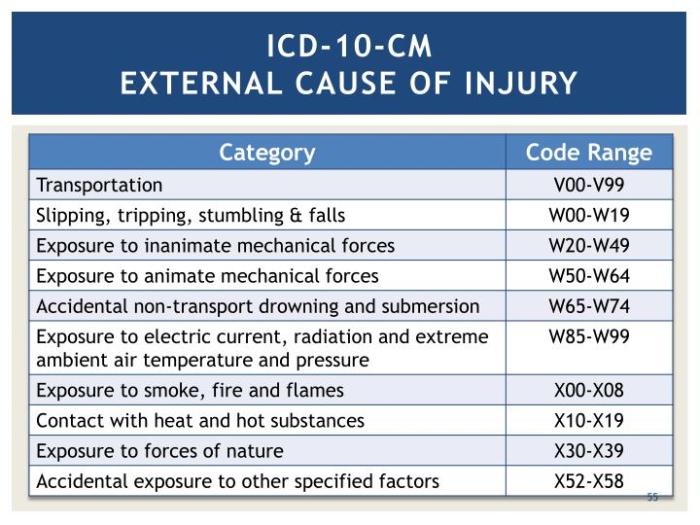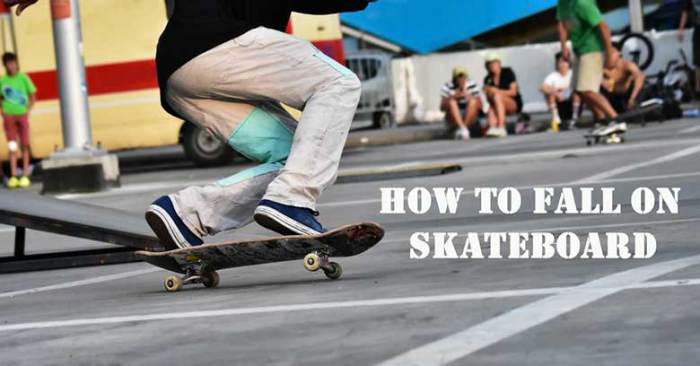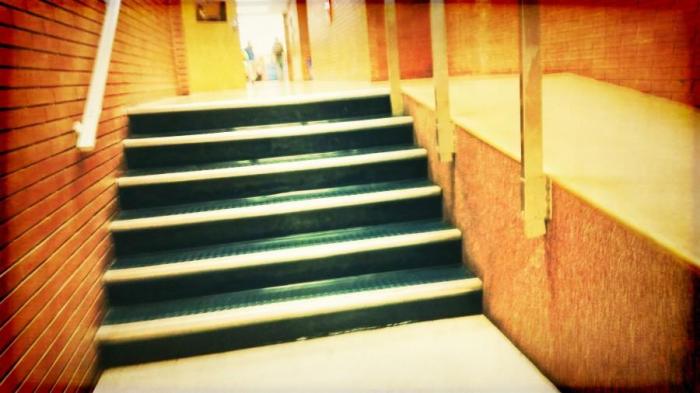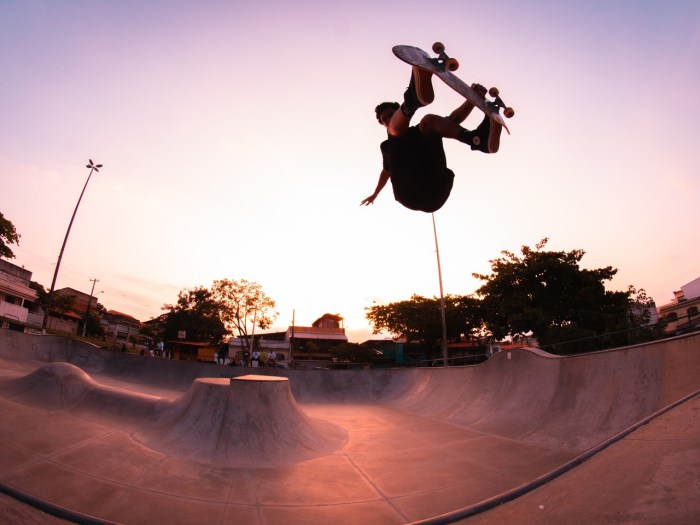Fall from skateboard icd 10: Skateboarding is a popular recreational activity, but it can also be dangerous. Falls from skateboards can result in a variety of injuries, ranging from minor scrapes and bruises to more serious head injuries. In this article, we will discuss the common injuries associated with falls from skateboards, the ICD-10 codes used to classify these injuries, and the various treatment options available.
We will also provide information on prevention strategies and rehabilitation after a fall from a skateboard.
Injuries Associated with Fall from Skateboard

Falling from a skateboard is a common occurrence, especially among beginners and those attempting complex maneuvers. These falls can result in a range of injuries, varying in severity from minor bruises to serious fractures or head trauma.
The most common injuries associated with skateboarding falls include:
Head Injuries, Fall from skateboard icd 10
- Concussion: A mild traumatic brain injury caused by a blow to the head, resulting in temporary loss of consciousness, confusion, and memory loss.
- Skull fracture: A break in the skull bone, which can be serious and require surgery.
Upper Extremity Injuries
- Wrist fractures: Breaks in the bones of the wrist, often caused by landing on an outstretched hand.
- Elbow fractures: Breaks in the bones of the elbow, which can be painful and limit mobility.
- Shoulder dislocations: When the shoulder joint is forced out of its socket, causing severe pain and instability.
Lower Extremity Injuries
- Ankle sprains: Injuries to the ligaments that connect the bones in the ankle, causing pain, swelling, and difficulty walking.
- Knee injuries: Damage to the knee joint, including ligament tears, cartilage damage, and fractures.
- Hip fractures: Breaks in the bones of the hip, which are particularly serious in older individuals.
ICD-10 Codes for Fall from Skateboard: Fall From Skateboard Icd 10

The International Classification of Diseases, Tenth Revision (ICD-10) is a medical classification system used to code and classify diseases, injuries, and other health conditions.
To treat a fall from a skateboard, refer to the ICD-10 code for guidance. If you’re looking for educational resources, check out abeka algebra 1 test 12 for assistance with your studies. Returning to the topic of skateboarding injuries, proper safety gear can help prevent falls and minimize the risk of serious harm.
For falls from skateboards, several ICD-10 codes are used to classify the resulting injuries. These codes are important for medical documentation and insurance purposes, as they provide a standardized way to describe the nature and severity of the injury.
ICD-10 Codes
- S92.0:Fall from skateboard, initial encounter
- S92.1:Fall from skateboard, subsequent encounter
- S92.2:Fall from skateboard, sequela
- S92.8:Other specified fall from skateboard
- S92.9:Fall from skateboard, unspecified
The specific ICD-10 code used will depend on the nature and severity of the injury, as well as the patient’s medical history and other factors.
Treatment Options for Fall from Skateboard Injuries

Injuries sustained from a fall from a skateboard can range in severity, from minor bruises to more serious fractures and head injuries. Treatment options will vary depending on the nature and severity of the injury.
Conservative Treatments
For minor injuries, such as sprains, strains, and bruises, conservative treatments are often sufficient. These may include:
- Rest: Avoiding activities that put stress on the injured area can promote healing.
- Ice: Applying ice packs to the injured area can help reduce pain and swelling.
- Physical therapy: Exercises and stretches prescribed by a physical therapist can help restore range of motion, strength, and function to the injured area.
Surgical Intervention
In cases of more severe injuries, such as fractures or dislocations, surgical intervention may be necessary. Surgery can help to:
- Repair broken bones
- Reduce dislocations
- Remove damaged tissue
The decision to undergo surgery is typically made on a case-by-case basis, taking into account factors such as the severity of the injury, the patient’s overall health, and the potential benefits and risks of surgery.
Prevention Strategies for Fall from Skateboard Injuries

Falling off a skateboard is a common occurrence, especially for beginners. However, taking proper precautions can significantly reduce the risk of injury. Wearing protective gear and practicing proper skateboarding technique are essential for staying safe while enjoying this thrilling activity.
Protective Gear
- Helmets:Helmets are the most important piece of protective gear for skateboarders. They protect the head from serious injuries in the event of a fall. Choose a helmet that fits snugly and is certified by a reputable safety organization.
- Wrist guards:Wrist guards help prevent wrist fractures, which are a common injury among skateboarders. They provide support and cushioning for the wrists during falls.
- Elbow pads and knee pads:Elbow pads and knee pads protect the elbows and knees from scrapes and bruises. They can also help prevent more serious injuries, such as dislocations and fractures.
Proper Skateboarding Technique
Proper skateboarding technique can help reduce the risk of falling and injury. Here are some tips:
- Learn the basics:Before hitting the streets, take some lessons from a qualified instructor or experienced skateboarder. They can teach you the proper way to balance, push, and brake.
- Practice in a safe environment:Start practicing in a flat, open area with no obstacles. As you gain confidence, you can gradually move to more challenging terrain.
- Wear comfortable shoes:Skateboarding shoes provide good support and grip, which can help prevent falls.
- Be aware of your surroundings:Pay attention to the traffic, pedestrians, and other obstacles around you. This will help you avoid collisions and falls.
Rehabilitation after Fall from Skateboard Injuries

Rehabilitation after sustaining injuries from a fall from a skateboard is crucial for restoring function, preventing long-term complications, and promoting overall well-being. The rehabilitation process typically involves a combination of physical therapy, occupational therapy, and other specialized interventions tailored to the specific needs of the individual.
Physical Therapy
Physical therapy plays a vital role in rehabilitation by addressing musculoskeletal impairments and restoring physical function. It involves exercises to improve range of motion, strength, balance, and coordination. Physical therapists also provide guidance on proper body mechanics and techniques to prevent future injuries.
Occupational Therapy
Occupational therapy focuses on improving the individual’s ability to perform daily activities and tasks that may have been affected by the injury. This includes training in adaptive techniques, assistive devices, and strategies to enhance independence and participation in everyday life.
Other Rehabilitation Measures
Depending on the nature and severity of the injury, other rehabilitation measures may be incorporated into the plan. These may include:
- Massage therapy to reduce muscle tension and promote relaxation
- Acupuncture to alleviate pain and improve circulation
- Hydrotherapy to utilize the therapeutic benefits of water for pain relief and mobility enhancement
The rehabilitation process is individualized and may vary in duration and intensity based on the specific needs of the patient. It is important to follow the guidance of healthcare professionals and adhere to the prescribed rehabilitation plan to optimize recovery and prevent long-term complications.
Commonly Asked Questions
What are the most common injuries associated with falls from skateboards?
The most common injuries associated with falls from skateboards are sprains, strains, and fractures. These injuries can occur in the wrists, ankles, knees, and head.
What are the ICD-10 codes for fall from skateboard injuries?
The ICD-10 codes for fall from skateboard injuries vary depending on the severity of the injury. Some of the most common codes include:
- S02.0 – Sprain of wrist
- S93.4 – Sprain of ankle
- S82.2 – Fracture of knee
- S06.0 – Concussion
What are the treatment options for fall from skateboard injuries?
The treatment options for fall from skateboard injuries vary depending on the severity of the injury. Conservative treatments, such as rest, ice, and physical therapy, are often effective for minor injuries. More serious injuries may require surgery.
What are some prevention strategies for fall from skateboard injuries?
Some prevention strategies for fall from skateboard injuries include wearing protective gear, such as helmets and wrist guards, practicing proper skateboarding technique, and skating in safe environments.
What is the rehabilitation process for fall from skateboard injuries?
The rehabilitation process for fall from skateboard injuries varies depending on the severity of the injury. Physical therapy and other rehabilitation measures can help to restore function and prevent long-term complications.